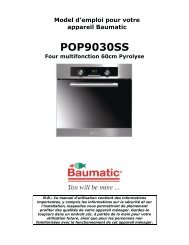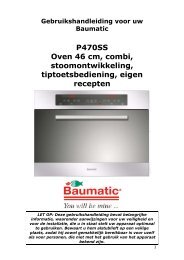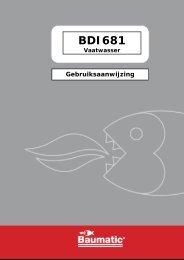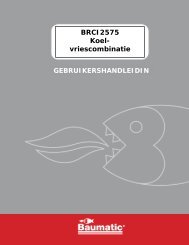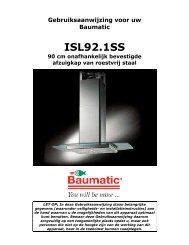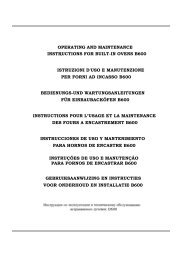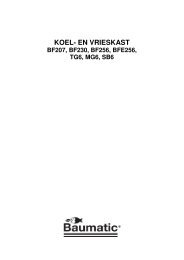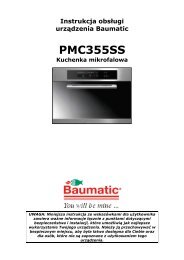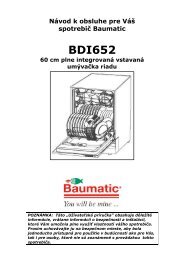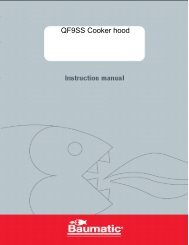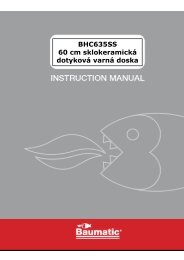BWD12.1 Fully integrated washer dryer - baumatic.cz
BWD12.1 Fully integrated washer dryer - baumatic.cz
BWD12.1 Fully integrated washer dryer - baumatic.cz
Create successful ePaper yourself
Turn your PDF publications into a flip-book with our unique Google optimized e-Paper software.
<strong>BWD12.1</strong><br />
<strong>Fully</strong> <strong>integrated</strong><br />
<strong>washer</strong> <strong>dryer</strong>
USER MANUAL FOR YOUR BAUMATIC<br />
<strong>BWD12.1</strong><br />
<strong>Fully</strong> <strong>integrated</strong> <strong>washer</strong> <strong>dryer</strong><br />
NOTE: This User Instruction Manual contains important<br />
information, including safety & installation points, which will<br />
enable you to get the most out of your appliance. Please keep it<br />
in a safe place so that it is easily available for future reference.<br />
DD 07/03/11<br />
2
Contents<br />
Environmental note 4<br />
Important safety information 5 - 6<br />
Specifications 7<br />
Description of the appliance 8 - 11<br />
Control panel 9<br />
Program options 9<br />
LCD display 10<br />
Detergent drawer 11<br />
Preparing the wash cycle 12 - 16<br />
Preparing your garments for washing 12<br />
A selection of wash care symbols 13<br />
Detergents and conditioners 13 - 14<br />
Program table 15 - 16<br />
Wash program guidance 16<br />
Selecting a wash program 17 - 18<br />
Selecting a separate drying program 18<br />
Selecting an automatic wash and dry program 19<br />
Cancelling or pausing a wash program 19 - 20<br />
Delay start feature 20<br />
Spin reduction button 20 – 22<br />
Setting a program option 22 – 23<br />
Child lock 23 - 24<br />
Maintenance and cleaning 24 - 26<br />
In daily use 24<br />
Control panel and washing machine cabinet 24<br />
Detergent drawer 25<br />
The washing machine drum 25<br />
Door gasket 26<br />
Error code failure system 26 - 27<br />
General troubleshooting 27 - 28<br />
Poor wash results 28 – 29<br />
Removing stains 29<br />
Stain removal rules 29<br />
Stain removal guide 30 - 31<br />
Cleaning the drain pump filter 31 - 32<br />
Installation 33 - 38<br />
Unpacking and removing the transit bolts 33 - 34<br />
Positioning and levelling the appliance 34 - 35<br />
Connecting to the mains water supply 35 - 36<br />
Water outlet 36<br />
Fitting the furniture door 36<br />
Power supply 37<br />
Before first use maintenance wash 38<br />
Contact details 39<br />
3
ENVIRONMENTAL NOTE<br />
Note: Before discarding an old appliance, switch off and<br />
disconnect it from the power supply. Cut off and render any plug<br />
useless. Cut the cable off directly behind the appliance to prevent<br />
misuse. This should be undertaken by a competent person. Disable<br />
the door lock to make sure that children cannot get stuck inside<br />
the appliance.<br />
4
IMPORTANT SAFETY INFORMATION<br />
General Safety<br />
Your safety is of the utmost importance to Baumatic.<br />
Please make sure that you read this instruction booklet<br />
before attempting to install or use the appliance. If you<br />
are unsure of any of the information contained in this<br />
booklet, please contact the Baumatic Advice Line.<br />
o Repairs to your appliance must only be carried out by a<br />
Baumatic engineer or one of its authorised service agents. Any<br />
attempt by an inexperienced person to repair the appliance,<br />
could result in injury or damage to your <strong>washer</strong> <strong>dryer</strong>.<br />
o If you notice that the mains cable is damaged. The appliance<br />
must not be used. The same applies if you notice that the<br />
worktop, control panel or base areas are damaged. As this could<br />
allow access to the internal components of the machine.<br />
o The appliance should be turned off and isolated from the mains<br />
supply, before either cleaning or maintenance work is attempted.<br />
o The mains cable must not be used to pull the plug out of the<br />
electrical socket.<br />
o The machine should not be sprayed with water.<br />
o The glass of the porthole door may become hot during the higher<br />
temperature wash programs.<br />
o The machine should be allowed to cool before carrying out an<br />
emergency drain or cleaning the drain filter.<br />
o It is possible for small animals to chew either mains cables or<br />
water hoses, which could cause an electric shock hazard or leak.<br />
Installation<br />
o The installation instructions contained within this user manual<br />
must be followed.<br />
o It is obligatory for the completed installation to comply with all<br />
relevant building regulations and local water authority<br />
requirements.<br />
5
o Before the first use of the appliance, we advise that a 90<br />
degree cotton wash is completed. No garments should be<br />
placed inside the machine; however a small amount of<br />
detergent must be used.<br />
During Use<br />
o It is recommended that the appliance is unplugged and the<br />
water supply is turned off after the machine is used.<br />
o This appliance is only designed to wash normal domestic wash<br />
loads. If you use your washing machine in any other way or it is<br />
incorrectly used, then Baumatic accepts no liability for any<br />
damage that might be caused and any guarantee will be void.<br />
o No attempt should be made to alter or modify the specifications<br />
of this appliance.<br />
o The detergents that you place in this appliance should be<br />
suitable for automatic washing machines. With regards to dosage<br />
levels, the detergent manufacturer’s recommendations should be<br />
followed.<br />
o You should not wash garments that have been in contact with<br />
flammable materials.<br />
o Your washing machine should not be used for dry cleaning.<br />
o If you use either dyes or bleaching agents inside this machine,<br />
then you should consult with the manufacturer of these products<br />
to make sure they are suitable for use in your washing machine.<br />
Baumatic cannot be held responsible for any damage that may<br />
result.<br />
Child Safety<br />
o Your washing machine should only be used by adults. You should<br />
not allow children in the area of the machine unsupervised. You<br />
should not let them touch the controls or play with the appliance.<br />
o It could be possible for a child or pet to gain access to the<br />
washing machine through the porthole door. Therefore please<br />
check the drum before using the appliance.<br />
o Any packaging that is removed from the machine should be kept<br />
away from children.<br />
o All detergents should be kept out of children’s reach in a safe<br />
place.<br />
6
Specifications<br />
13 wash programs/2 drying programs<br />
6kg wash load/3kg drying load<br />
1100 rpm maximum spin speed<br />
LCD display<br />
Delay start timer with remain time indicator<br />
3 Option buttons: Easy iron<br />
Extra rinse<br />
Intensive wash<br />
Unbalance control system<br />
Foam protection<br />
Suspend the clothes in water option<br />
Door safety lock<br />
Child lock<br />
Stainless steel drum<br />
Adjustable feet<br />
Error code failure system<br />
Aqua Spray rain shower effect- This additionally showers the<br />
wash load throughout the wash cycle. It helps to improve the<br />
wash and rinsing efficiency.<br />
Appliance dimensions Aperture dimensions<br />
Height: 820 – 850 mm 820 mm<br />
Width : 590 mm 600 mm<br />
Depth: 550 mm 600 mm<br />
Energy efficiency<br />
Energy rating B<br />
Wash performance A<br />
Water extraction performance C<br />
7
Description of the appliance<br />
8
Control panel<br />
Wash program selection knob<br />
This control knob allows you to select the wash program of your<br />
choice. To activate it you should press in the program selection knob,<br />
to pop out the control.<br />
Start/Stop button<br />
Once a wash program has been selected, this button should be<br />
pressed to start the wash cycle.<br />
Program option button<br />
This button needs to be pressed after a wash program has been<br />
selected, but before the wash program has been started. If you<br />
select a different wash cycle after pressing a program option, it<br />
will need to be reselected.<br />
Extra rinse: This function increases the level of the final rinse for the<br />
selected wash program. This should be selected if large loads are being<br />
washed or the garments belong to somebody who has sensitive skin.<br />
This option will increase the amount of water the appliance uses.<br />
Easy iron: This function helps to prevent garments from creasing by<br />
carrying out a program where the rotation of the drum will fluff out the<br />
garments, after the spin cycle has completed. This should make the<br />
garments easier to iron.<br />
Intensive wash: This function should be selected if you are washing<br />
heavily soiled, stained clothes. It achieves a better level of wash<br />
performance by extending the wash program that you have selected.<br />
9
LCD display<br />
1. Wash program phases:<br />
o Prewash<br />
o Wash<br />
o Rinse<br />
o Spin and drain<br />
o Drying<br />
2. Spin speed.<br />
3. Program number (for a few seconds) and then program<br />
duration.<br />
4. Program options:<br />
o Easy iron<br />
o Extra rinse<br />
o Intensive wash<br />
10
Detergent drawer<br />
Pre wash section<br />
This compartment should have detergent placed in, if you are going to<br />
select a wash program that has a pre wash as part of it.<br />
Main wash section<br />
This compartment should have detergent placed in it (you should also<br />
put a water softening agent in this section, if you use one). The<br />
detergent will be added to the drum at the start of the main wash<br />
program.<br />
Conditioner section<br />
This compartment should be used for liquid conditioners (fabric<br />
softener, starch). They will be added to the wash load during the final<br />
rinse.<br />
11
Preparing the wash cycle<br />
Preparing your garments for washing<br />
o Your washing should be sorted out, according to<br />
the fabric type and the wash care symbol that is<br />
printed on the garment’s wash care label. (see<br />
separate section on wash care symbols).<br />
o Your washing should also be sorted out<br />
according to the degree of soiling.<br />
o Check all pockets on a garment to make sure<br />
that they are empty.<br />
o Remove any detachable metal items (badges,<br />
paperclips, safety pins etc).<br />
o Zips should be closed, duvet covers and pillow cases should be<br />
buttoned up and any loose straps should be tied up. This will<br />
help to prevent other garments from getting damaged during the<br />
wash.<br />
o Woollens and knitted coloured fabrics should be turned inside out<br />
before being washed in the appliance.<br />
o Small delicate items (tights, baby socks) should be placed in<br />
either a washing net or a zipped pillow case. Bras suitable for<br />
machine washing, that contain a wire, should also be washed in<br />
this manner.<br />
o Curtains should be handled with particular care. All plastic hooks<br />
or metal strips must be removed before being washed in the<br />
appliance.<br />
o Coloured items and whites should be washed<br />
in separate wash cycles.<br />
o New garments often contain an excess of<br />
dye, therefore it is advisable to wash them separately for their<br />
first wash.<br />
o Garments should be unfolded and shook out before being placed<br />
inside the machine.<br />
12
A selection of wash care symbols<br />
Washing<br />
Dry<br />
cleaning<br />
Spin<br />
<strong>dryer</strong><br />
Ironing<br />
Boiling<br />
temp<br />
95°C<br />
Delicate<br />
temp<br />
30°C<br />
Normal<br />
110°C<br />
Normal<br />
temp<br />
60°C<br />
Delicate<br />
temp<br />
40°C<br />
Low<br />
150°C<br />
Normal<br />
temp<br />
40°C<br />
Hand<br />
wash<br />
only<br />
High<br />
200°C<br />
Do not<br />
wash!<br />
All<br />
solvents<br />
Do not<br />
dry!<br />
Do not<br />
iron!<br />
Bleachable<br />
in cold<br />
water<br />
All but TRI<br />
Hang to<br />
dry<br />
Do not<br />
bleach!<br />
Benzine<br />
only<br />
Drip dry<br />
Wool<br />
seal<br />
Do not<br />
clean!<br />
o The wash care symbols should be used to help you to select the<br />
most suitable wash program. They will also help you to sort your<br />
laundry into different loads, depending on the fabric type and the<br />
highest temperature which the garment can be washed at.<br />
o If the wash care label does not appear in the above table, then<br />
please refer to the washing machine program chart. This gives<br />
more detailed descriptions of the types of fabric that are suitable<br />
to be washed using a particular wash program.<br />
Detergents and conditioners<br />
The amount of detergent that you need to use in your appliance, will<br />
depend on<br />
o The degree of soiling. Lightly soiled garments in general<br />
require less detergent.<br />
o The size of the wash load. A smaller wash load will require a<br />
reduction in the amount of detergent.<br />
o The hardness of your tap water. The harder your water is,<br />
then the more detergent you will need to use. The detergent<br />
manufacturers normally give guidance as to how much extra<br />
detergent should be used, depending on the hardness of the<br />
water.<br />
Dry<br />
flat<br />
13
Liquid detergent<br />
If you are using liquid detergent, then in the majority of cases the<br />
liquid should be placed inside the dosing device supplied by the<br />
detergent manufacturer. All instructions on the detergent packaging<br />
should be followed.<br />
Water softening agents<br />
If your tap water is hard, then it may be prudent to utilise a water<br />
softening agent. This will help to ensure that the appliance does not<br />
become clogged with hard water deposits. You may also find that it will<br />
allow you to lessen the amount of detergent that you are using.<br />
When using any detergent or water softening<br />
agent, the recommendations of the<br />
manufacturer should be followed.<br />
14
NOTE: the KWh and litre consumptions and program durations may<br />
vary depending on the type and amount of clothes being washed, your<br />
mains water pressure, etc.<br />
(*) Program for wash and energy consumption assessment, in<br />
accordance with standard EN60456 (press intensive wash button).<br />
Wash program guidance<br />
o A particular program option can only be selected if the program<br />
table advises that it is possible with the wash cycle you have<br />
selected.<br />
o The washing machine automatically selects a spin speed for a<br />
particular wash program. However it is possible to reduce the spin<br />
speed by using the spin reduction feature.<br />
o Important: You should make sure that the selected spin speed is<br />
appropriate for the garments that you are washing.<br />
o If you use the spin reduction feature, you can make the machine<br />
not go into a spin cycle. If you pick this option, then the machine<br />
will stop with water in the drum.<br />
o Important: Before opening the door of the appliance, you MUST<br />
select the drain program to clear this water.<br />
o The LCD display shows an approximate time for the selected wash<br />
cycle. Please note that factors external to the machine, e.g. the<br />
temperature of your water supply, your water pressure etc. can<br />
affect the time it takes for the wash cycle to complete.<br />
16
Selecting a wash program<br />
Load your laundry and put detergent in the relevant<br />
compartment of the soap drawer.<br />
Close the porthole door firmly.<br />
Activate the pop out<br />
program selector knob by<br />
depressing it.<br />
Select the most<br />
appropriate wash program<br />
for the garments that you<br />
are washing, by turning the<br />
program selector knob.<br />
o The LCD display will briefly flash the wash program number that<br />
you have selected and then show the approximate time that it<br />
will take the chosen wash cycle to complete.<br />
Select any program options by using the program option button<br />
underneath the LCD display (for more information, please refer<br />
to the “setting a program option” section).<br />
o Any program option that you select, will affect the length of time<br />
that the wash cycle will take to complete. The LCD display will<br />
update to reflect this change.<br />
Press the Start/Stop button.<br />
o After approximately 5 seconds, you will hear your washing<br />
machine start the wash cycle.<br />
o If there is a power failure or the plug is pulled out of the<br />
socket when a wash cycle is in progress., The wash<br />
program will continue, once power has been restored.<br />
o Whilst the wash program is<br />
in progress, the program<br />
phase and time remaining to<br />
the end of the wash cycle will<br />
appear on the display.<br />
17
o The active phases will appear at the top of the display, as the<br />
wash program progresses. The time remaining until the end of<br />
the program will update throughout the wash cycle. Please note<br />
that it does not count down in “real time”.<br />
o Any program option can be selected once the wash cycle is<br />
already in progress, providing that the stage in the wash cycle<br />
that the option will affect has not already passed. (E.g. you<br />
cannot select an intensive wash, once the machine has reached<br />
the rinse stage of the wash cycle).<br />
Selecting a separate drying program<br />
Activate the pop out program selector knob by depressing it.<br />
o Select the most appropriate drying cycle for the garments<br />
that you wish to dry, by turning the program selector knob.<br />
o IMPORTANT: Please take note of the maximum size of<br />
load that you can dry in this appliance. This information<br />
is contained in the program chart.<br />
o Select the drying time in<br />
minutes, by using the<br />
drying time button.<br />
o The drying time will<br />
appear on the LCD<br />
display and will increase<br />
each time the drying<br />
time button is pressed.<br />
o Press the START/STOP button to get the drying cycle to<br />
commence.<br />
18
Selecting an automatic wash and dry program<br />
Activate the pop out program selector knob by depressing it.<br />
Select the most appropriate wash program for the garments that<br />
you are washing, by turning the program selector knob.<br />
o The LCD display will briefly flash the wash program number that<br />
you have selected and then show the approximate time that it<br />
will take the chosen wash cycle to complete.<br />
Select any program options by using the program option button<br />
underneath the LCD display (for more information, please refer<br />
to the “setting a program option” section).<br />
o Any program option that you select, will affect the length of time<br />
that the wash cycle will take to complete. The LCD display will<br />
update to reflect this change.<br />
o Select the drying time in minutes, by using the drying time<br />
button.<br />
o The drying time will appear on the LCD display and will increase<br />
each time the drying time button is pressed.<br />
o Press the START/STOP button to get the automatic wash and dry<br />
cycle to commence.<br />
o IMPORTANT: If you select a wash and dry program, your<br />
wash load must not be over 4kg for NORMAL wash<br />
programs and 1.5kg for DELICATE wash programs.<br />
Cancelling or pausing a wash program<br />
To stop a wash program once a wash cycle is in progress, you<br />
should turn the program selection knob.<br />
o The appliance will go onto PAUSE status and the wash program<br />
will be cancelled.<br />
o The door will remain locked for two minutes before it is possible<br />
to open the door and take out the garments.<br />
Before opening the porthole door, you MUST<br />
drain the appliance; otherwise there may still<br />
be water in the drum when you open the<br />
door.<br />
19
o It is also possible to put the machine into PAUSE status by<br />
pressing the START/STOP button whilst the wash cycle is in<br />
progress. However this will not cancel the wash program and to<br />
restart the wash cycle, you should press the START/STOP button<br />
again.<br />
Delay start feature<br />
Your appliance has a delay start feature, which allows you to pause<br />
the start of a wash cycle until a later time.<br />
Follow the process listed under “Selecting a wash program”<br />
Before pressing the<br />
START/STOP button, you<br />
should select the length of<br />
time that you want to<br />
delay the wash program<br />
for by pressing the delay<br />
start button.<br />
o Each time the delay start button is pressed, the start of the wash<br />
cycle will be delayed by one hour. The LCD display will show how<br />
many hours the wash cycle is being delayed for in the bottom<br />
right hand corner.<br />
o Press the START/STOP button.<br />
o To cancel a time delay that has been set, you should press the<br />
delay start button successively. Once 24 hours shows on the LCD<br />
display, you need to press the delay start button one further<br />
time and the delay start will be cancelled.<br />
o If you alter the wash program whilst a delay start has been set,<br />
this will also cancel the delay start.<br />
Spin reduction button<br />
Your washing machine will automatically select an appropriate spin<br />
speed for each wash program. However it is possible to decrease<br />
the spin speed that it automatically selects, by pressing the spin<br />
reduction button.<br />
Turn the wash program selection knob to the wash program<br />
that you want to use.<br />
20
Press the spin selection button and the spin speed will reduce<br />
in 100 rpm increments.<br />
o It is possible to reduce the spin speed from the one<br />
automatically selected by the wash program, down to<br />
400rpm.<br />
If you continue to press the spin reduction button after<br />
400rpm appears. Then will appear in the LCD display. This<br />
means that the “No spin” option has been selected and at the<br />
end of the wash cycle, the machine will not spin at all and the<br />
wash program will finish after it has drained.<br />
If you press the spin<br />
reduction button again,<br />
then will appear in the<br />
LCD display. This means<br />
that the “Anti-crease”<br />
option has been selected.<br />
The clothes will be held in<br />
water, until you select a<br />
spin or drain program.<br />
This feature is useful if you are not going to be present when<br />
the wash cycle completes, as it will lessen the chance of the<br />
garments becoming creased.<br />
After the appliance completes the last rinse, the symbol will<br />
flash and the drum will rotate approximately every 3 minutes.<br />
Press the spin reduction button until the spin speed that you<br />
require appears in the LCD display, then press the<br />
START/STOP button.<br />
21
If you want the appliance to drain only, press the spin<br />
reduction button until the symbol appears in the LCD<br />
display, then press the START/STOP button.<br />
YOU MUST DO ONE OF THESE STEPS BEFORE<br />
OPENING THE DOOR OF THE APPLIANCE.<br />
OTHERWISE YOU COULD OPEN THE PORTHOLE<br />
DOOR WHILST THERE IS STILL WATER IN THE<br />
DRUM.<br />
Setting a program option<br />
You should ensure that the garments you are<br />
washing are suitable for suspending in water<br />
before selecting this option. Garments should not<br />
be suspended in water for a prolonged period.<br />
o There are three program options that you can select (providing<br />
that the wash program chart indicates that a particular option<br />
can be selected with a particular wash program).<br />
o To select a program option,<br />
you should press the<br />
selection button until the<br />
neon comes on next to the<br />
program option that you<br />
want.<br />
o By pressing the select<br />
button several times, you<br />
can choose between<br />
several combinations of<br />
program option. One, two<br />
or three program options<br />
can be selected at a time,<br />
depending on the wash<br />
program that you have<br />
selected.<br />
o Any program option that you select, will affect the length of time<br />
the wash cycle will take to complete. The LCD display will update<br />
to reflect this change.<br />
Press the START/STOP button.<br />
22
o The program option button needs to be pressed after a wash<br />
program has been selected, but before the wash program has<br />
been started. If you select a different wash cycle after pressing a<br />
program option, it will need to be reselected.<br />
o Any program option can be selected once the wash cycle is<br />
already in progress, providing that the stage in the wash cycle<br />
that the option will affect has not already been passed. (E.g. you<br />
cannot select an intensive wash, once the machine has reached<br />
the rinse stage of the wash cycle).<br />
Child lock<br />
Your appliance has a child lock option, if this is set, it will mean that<br />
nobody can affect the operation of the wash program once it has<br />
started.<br />
The child lock should be activated, once a wash program has been<br />
selected and any program options that you wish to use.<br />
o To activate the child lock, you should hold down the START/STOP<br />
button for at least three seconds. When the child lock is set, a<br />
symbol will appear on the LCD display.<br />
o The child lock option will end once the wash cycle completes.<br />
23
o If you want to cancel the child lock option before the wash<br />
program completes. You should hold down the START/STOP<br />
button for at least three seconds. When the symbol<br />
disappears from the LCD display, the child lock option has been<br />
cancelled.<br />
Maintenance and cleaning<br />
In daily use<br />
Once a wash cycle has completed, you should pull out the<br />
detergent drawer slightly, so it can dry out.<br />
Leave the porthole door ajar for a short while after a wash<br />
cycle has completed. This should help to prevent stagnant<br />
smells and to protect the door seal.<br />
Close the water tap.<br />
We suggest that you disconnect the appliance from your<br />
mains supply, when it is not in use.<br />
Control panel and washing machine cabinet.<br />
IMPORTANT: Do not use any abrasive cleaner or household polish on<br />
either the control panel or operating parts.<br />
Wipe over the control panel and the external surface of the<br />
machine using a brand new damp cloth with warm water.<br />
If you ever spill any liquid detergent or conditioner from the<br />
detergent drawer onto the washing machine cabinet, then<br />
these should be cleaned up immediately as they could be<br />
corrosive.<br />
24
Detergent drawer<br />
Occasionally the detergent drawer should be cleaned.<br />
The<br />
washing machine drum<br />
o Pull the detergent drawer out<br />
as far as it will go and then<br />
remove the drawer by pulling<br />
firmly.<br />
o Use warm water and a brush to thoroughly clean<br />
the three compartments of the detergent drawer.<br />
o Clean the area that the detergent drawer slides<br />
into with a brush.<br />
o You should also clean the siphon that sits inside<br />
of the conditioner section of the detergent<br />
drawer. Taking care to make sure that the siphon<br />
is inserted back in the drawer correctly.<br />
o Replace the detergent drawer by placing it back<br />
into the slot. Then push the drawer fully<br />
back<br />
into position.<br />
The drum of your washing machine is constructed from stainless steel.<br />
However if there are objects that can rust placed<br />
inside the drum, then<br />
it is possible for the drum to become stained.<br />
IMPORTANT: Do not use a descaling agent, iron/steel<br />
wool or<br />
scouring<br />
agents to clean the drum of your appliance.<br />
Remove any rust stains on the<br />
drum with an appropriate<br />
stainless steel cleaning agent.<br />
25
Door<br />
gasket<br />
You should regularly check to see if any deposits have<br />
formed, or there are any foreign bodies in the rubber door<br />
gasket. This sits inside the opening of the porthole door.<br />
Error<br />
code failure system<br />
If your appliance senses that it is not operating correctly, then an error<br />
code<br />
may appear in the LCD display.<br />
The following error codes can possibly be remedied<br />
by the customer<br />
and<br />
the steps outlined below should be followed.<br />
BEFORE COMPLETING ANY MAINTENANCE ON THE APPLIANCE,<br />
IT SHOULD<br />
BE DISCONNECTED FROM YOUR MAINS POWER<br />
SUPPLY.<br />
No display<br />
o Power failure.<br />
o Check that the power plug<br />
is in the mains socket correctly.<br />
o Check the mains fuse.<br />
F01- No water coming into the machine<br />
o Check the water pressure of your mains water supply.<br />
o Clean the mesh filter that sits in the inlet hose.<br />
o Make sure<br />
the water tap that the machine is connected to is turned<br />
on fully.<br />
F02- The machine will not drain<br />
or spin<br />
o Clean the drain pump filter.<br />
o Check the drain hose is not blocked or kinked.<br />
F04- The machine does not start<br />
o Check that the<br />
door has been shut properly before commencing a<br />
wash cycle.<br />
C03- The machine has sensed an out of balance load<br />
o This may be due to uneven distribution of clothes<br />
in the drum,<br />
which may cause an excessive level of vibration.<br />
o See the “General troubleshooting” section.<br />
F05<br />
– F10- Contact Baumatic Service Department<br />
Once the machine has been plugged back into your mains power<br />
supply, to clear the fault code from the LCD display, you should turn<br />
on the machine<br />
and hold down the Start/Stop button for approximately<br />
5 seconds.<br />
26
If a fault code reappears after following the<br />
above advice and clearing the fault code. You<br />
should turn the wash program selection knob<br />
to the off position. Disconnect the appliance<br />
from your mains supply. Then arrange for an<br />
engineer to attend the appliance. You should<br />
contact the Baumatic Service Department on<br />
(0118) 933 6911.<br />
IF AN ENGINEER ATTENDS DURING THE<br />
GUARANTEE PERIOD AND FINDS THAT A FAULT<br />
HAS BEEN CAUSED BY AN ITEM ON THE ERROR<br />
CODE LIST, WHICH COULD HAVE BEEN CLEARED BY<br />
THE CUSTOMER. THEN YOU MAY BE LIABLE FOR<br />
THE COST OF THE SERVICE CALL.<br />
General troubleshooting<br />
Water under the washing machine<br />
o Tighten the drain pump filter.<br />
o Check the drain and inlet hose and make sure that it is fully<br />
tightened.<br />
Washing machine vibrates during the spin cycle<br />
o Check that the transport locking devices have been removed (see<br />
installation instructions).<br />
o Make sure that the washing machine is installed on a flat and level<br />
floor.<br />
o Ensure that all four feet are resting firmly on the floor, by pressing<br />
down on each corner and making sure that the appliance is stable.<br />
o If it is unstable then follow the “Positioning and levelling the<br />
appliance” section.<br />
Poor spin results<br />
o Clean the drain pump (see “Cleaning the drain pump filter” section).<br />
Water in the detergent dispenser<br />
o Although there will be some water residue left in the detergent<br />
drawer after a wash cycle has completed. If the drawer is full of<br />
water then you may need to clean the detergent drawer.<br />
Spinning starts late or the machine does not spin<br />
o The imbalance control system has activated because the laundry<br />
is unevenly distributed in the drum.<br />
27
o The appliance will redistribute the laundry by reversing the drum<br />
rotation. This may take several attempts before the laundry is<br />
evenly distributed and normal spinning can resume.<br />
o If the laundry is still not evenly distributed after 10 minutes, the<br />
machine will not spin. In the event of this, redistribute the load<br />
manually and select the program again.<br />
Uneven load distribution can be caused by too large a wash<br />
load or too small a wash load. It can also occur if a single item<br />
if washed inside the appliance.<br />
Poor wash results<br />
My garments are looking grey and there are limescale<br />
deposits present in the drum of my washing machine.<br />
o There is not enough detergent being added.<br />
o The incorrect detergent is being used.<br />
o Stains are not being pre-treated.<br />
o The correct wash program or wash temperature was not<br />
selected.<br />
I have followed the advice given above, but my<br />
garments are still coming out with grey stains on them.<br />
o The garments are soiled with oils, ointments or grease<br />
and were washed without enough detergent.<br />
o The wash temperature selected was too low.<br />
o Fabric conditioner has come into contact with the<br />
garments. If this happens try to wash out these stains<br />
as quickly as you can and try to avoid getting<br />
conditioner on the garments in future.<br />
After the final rinse, I can still see foam.<br />
o Modern detergents can result in there still being foam in the final<br />
rinse, this does not mean that the washing is not being rinsed<br />
properly.<br />
28
There is white residue on my garments when I remove<br />
them from the appliance.<br />
o Modern detergents can contain insoluble contents, and white<br />
residue after a wash cycle is not necessarily a sign of the garments<br />
not being rinsed properly.<br />
o You should shake out the garment or brush it off. In future possibly<br />
turn the garment inside out before it is washed. You may wish to<br />
move from a powder detergent and switch to a liquid detergent<br />
instead.<br />
Removing stains<br />
Garments that are covered in stains, grease or are heavily soiled may<br />
need to be pre-washed or soaked before being placed inside of the<br />
<strong>washer</strong> <strong>dryer</strong>.<br />
o Soaking helps to remove protein-type stains, like blood, milk or<br />
grass.<br />
o Pre-washing helps to loosen soil before the main wash.<br />
Stain removal rules<br />
o Use warm water for soaking or pre-washing stained laundry. Hot<br />
water can set stains.<br />
o Most stains are easier to remove when they are fresh.<br />
o Before treating any stain try to establish; what kind of stain it is,<br />
how old the stain is, what the fabric type is and whether the<br />
fabric is colourfast (check the care label to find this out).<br />
o Washing and drying can fix some stains.<br />
o When bleach is recommended, use a mild fabric bleach that is<br />
safe for the fabric.<br />
o If you need to use a stain remover, put the stained area face<br />
down on a paper towel or white cloth. Apply the stain remover to<br />
the back of the stain. This forces the stain off the fabric, instead<br />
of through it.<br />
29
Stain removal guide<br />
Stain Removal Method<br />
Alcoholic<br />
beverages<br />
The stain should be first washed with cold water, then<br />
wiped with glycerine and water and rinsed with water<br />
mixed with vinegar.<br />
Shoe polish The stain should be softly scratched without ruining the<br />
material, then rubbed with detergent and rinsed. In case<br />
it is not eliminated, rub with 1 unit of pure alcohol (96<br />
degrees) mixed in 2 units of water and then washed with<br />
lukewarm water.<br />
Tea and<br />
coffee<br />
Chocolate<br />
and cocoa<br />
Tomato<br />
paste<br />
Meat broth/<br />
egg<br />
Grease and<br />
oil stains<br />
Stretch the stained area of material on the top of a<br />
container and pour water as hot as the material can<br />
endure on it. If the type of material is suitable, wash it<br />
with lye.<br />
Leave your clothes in cold water and rub with soap or<br />
detergent, wash it in the highest temperature that the<br />
material type can endure. If there is still a stain of oil left,<br />
wipe with oxygenated water (in proportion of 3%).<br />
Scrape the dried pieces without ruining the material, then<br />
leave in cold water for about 30 minutes and wash by<br />
rubbing with detergent.<br />
Eliminate the dried stain residues and wipe with a sponge<br />
or soft cloth wetted in cold water. Rub with detergent and<br />
wash with diluted lye.<br />
First wipe the residues. Rub the stain with detergent and<br />
then wash with lukewarm soapy water.<br />
Mustard First apply glycerine to the stained area. Rub with<br />
detergent and then wash. If the stain still does not<br />
disappear, wipe with alcohol (on synthetic and coloured<br />
cloth, a mixture of 1 unit alcohol, 2 units water should be<br />
used).<br />
Blood stain Lay your clothes in cold water for 30 minutes. If the stain<br />
still does not disappear, lay in mixture of water and<br />
ammonia (3 table-spoons of ammonia in 4 litres of water)<br />
for 30 minutes.<br />
Cream, icecream<br />
and<br />
milk<br />
Lay your clothes in cold water and rub the stained area<br />
with detergent. If the stain has still not disappeared,<br />
apply lye on the fabric of your clothes in proper<br />
proportion. (Do not use lye on coloured clothes).<br />
Mould Mould stains should be cleaned as soon as possible. The<br />
stain should be washed with detergent, and if it does not<br />
disappear, it should be wiped with oxygenated water (in<br />
proportion of 3%).<br />
Ink Hold the stained area under cold water and wait until the<br />
inky water completely runs off. Then rub with water<br />
diluted with lemon juice and detergent. Wait five minutes<br />
and then wash.<br />
Fruit Stretch the stained area of your clothes on the top part of<br />
a container and pour cold water on it. Do not pour hot<br />
water on the stain. Wipe with cold water and apply<br />
glycerine. Wait for 1-2 hours and rinse after wiping with a<br />
few drops of white vinegar.<br />
30
Grass stain Rub the stained part with detergent. If the type of fabric<br />
is suitable for use of lye, wash it with lye. Rub your<br />
woollen clothes with alcohol (for coloured one, a mixture<br />
of 1 unit pure alcohol and 2 units of water).<br />
Oil paint The stain should be eliminated before it dries by applying<br />
thinner on it. Then it should be rubbed with detergent and<br />
washed.<br />
Burnt stain If your fabric is suitable for the use of lye, you can add<br />
lye into your washing water. For woollen fabrics, a cloth<br />
dampened in oxygenated water should be pressed on the<br />
stain and it should be ironed with a dry cloth on it. It<br />
should be washed after rinsing well.<br />
Cleaning the drain pump filter<br />
IMPORTANT: Switch off your washing machine and<br />
disconnect the plug from your mains supply.<br />
You should clean out the filter approximately every twenty<br />
washes. If the drain pump filter is not cleaned regularly, then<br />
your appliance may find it difficult to pump out water<br />
efficiently.<br />
Use a coin to turn the filter cap.<br />
Pull out the filter cap.<br />
Place a container under the drain pump<br />
filter, to collect any excess water that may<br />
come out of the drain pump when it is<br />
removed.<br />
31
Turn the filter a quarter turn anti clockwise, water will<br />
start to come out of the drain pump. Continue to turn the<br />
filter anti clockwise until you reach a half turn, more<br />
water will come out of the drain pump.<br />
When all the water has drained<br />
out of the washing machine,<br />
turn the filter several times anti<br />
clockwise, until it can be<br />
removed completely.<br />
Remove the filter and rinse out<br />
the filter under the tap.<br />
Remove any debris from the<br />
filter.<br />
Remove any debris that is in the area of the appliance that you<br />
removed the drain pump filter from.<br />
Screw the filter clockwise back into position, making sure that it is fully<br />
tightened. You should keep turning until you cannot turn it any further.<br />
Refit the filter cap.<br />
IMPORTANT: Do not perform this operation if the appliance has<br />
stuck on a cycle, until the water inside the machine has cooled<br />
sufficiently. Otherwise the water that comes out of the drain<br />
pump filter may still be hot.<br />
32
Installation<br />
IMPORTANT: THIS INSTALLATION MUST BE<br />
COMPLETED BY A SUITABLY QUALIFIED PERSON.<br />
BAUMATIC ONLY SANCTION THE INSTALLATION<br />
GIVEN IN THIS INSTRUCTION MANUAL. YOU<br />
SHOULD KEEP THE TRANSIT PACKAGING, IN CASE<br />
YOU NEED TO TRANSPORT THE MACHINE IN THE<br />
FUTURE.<br />
Unpacking the machine and removing the transit bolts<br />
Remove the base, corner<br />
protection pieces and top<br />
cover.<br />
Locate the three transit<br />
bolts that secure the drum<br />
in position,<br />
whilst the<br />
appliance<br />
transported.<br />
is being<br />
Using a screwdriver,<br />
unscrew the three plastic<br />
transit bolt covers.<br />
Loosen and remove the<br />
three transit bolts.<br />
33
IMPORTANT: The transit bolts MUST<br />
washing<br />
machine is used for the first time.<br />
Positioning<br />
and levelling the appliance<br />
Using a screwdriver, refit<br />
the three plastic transit<br />
bolt covers that you<br />
removed previously.<br />
be removed before your<br />
Place the washing machine on a solid and level floor surface.<br />
DO NOT PLACE THE WASHING MACHINE ON A CARPET.<br />
<br />
<br />
<br />
Loosen the adjustable feet<br />
that are positioned on the<br />
base of the appliance.<br />
Slacken off the lock nut on each of the washing<br />
machine feet using a spanner.<br />
Adjust the feet to level off the washing<br />
machine.<br />
34
Once levelled correctly, you should tighten the<br />
lock nut back up on each of the washing<br />
machine feet using a spanner.<br />
IMPORTANT:<br />
When the washing machine is positioned in the location<br />
where it will be used. Make sure that all four<br />
feet are resting firmly on<br />
the<br />
floor, by pressing down on each corner and checking that the<br />
appliance stands still.<br />
Connecting to the mains water supply<br />
The water inlet hose will be inside the drum of your washing<br />
machine, when you receive<br />
the appliance.<br />
<br />
Connect and fully tighten the inlet hose to<br />
the threaded<br />
inlet valve that is located at<br />
the rear of the washing machine. You<br />
should connect the end with the right<br />
angle connector on it to the back of your<br />
appliance.<br />
Connect the other end of the inlet hose to your mains<br />
water supply<br />
35
IMPORTANT: There should be a filter sitting inside the end of the<br />
inlet hose that connects to your mains water supply. The inlet hose<br />
may leak if this filter is missing. This filter is supplied with the<br />
appliance, you should contact Baumatic to obtain one, if it is<br />
missing.<br />
<br />
<br />
Tighten the inlet hose to your mains supply fully, but do not over<br />
tighten as this may distort the filter that sits in the end of the inlet<br />
hose.<br />
Test for any leaks.<br />
Water outlet<br />
Secure the drain hose, so that it cannot move whilst the washing<br />
machine is in use.<br />
Place the end of the drain hose on your drain pipe. Push it a<br />
short way down into your drain pipe.<br />
IMPORTANT: Do not insert the drain hose too deeply into the<br />
water pipe, as this may cause siphoning.<br />
NEVER EXTEND THE DRAINAGE<br />
HOSE FROM ITS ORIGINAL<br />
LENGTH.<br />
Fitting the furniture door<br />
o Please refer to the building in template for instructions on how to<br />
fit your <strong>integrated</strong> appliance and connect the furniture door to<br />
the product.<br />
36
Power supply<br />
IMPORTANT: As your appliance is a built in product, the<br />
electrical socket must still be accessible once the<br />
appliance is installed.<br />
Consult the rating<br />
plate, located on<br />
the inner rim of the<br />
porthole door<br />
of the<br />
appliance BEFORE<br />
making the<br />
electrical<br />
connections. Ensure<br />
that the voltage<br />
reaching the plug,<br />
is the same as that<br />
on the rating plate.<br />
DO NOT REMOVE THE RATING PLATE AS THE<br />
INFORMATION ON IT IS IMPORTANT.<br />
The moulded plug that is supplied with the appliance must be<br />
placed into an earthed and insulated socket.<br />
Broken or damaged power<br />
leads must only be replaced by a<br />
suitably qualified person. A power lead of a similar type must be<br />
used in replacement.<br />
Power lead type – H 0 V V – F 3G 1,5.<br />
IMPORTANT: We do not recommend<br />
that this appliance is<br />
connected to an extension lead.<br />
37
Before first use maintenance wash<br />
o Select a Normal 90°C wash program.<br />
o<br />
o When your washing machine<br />
has been correctly installed,<br />
we recommend<br />
that you<br />
perform a maintenance wash<br />
cycle.<br />
o This will check that all<br />
aspects of the installation<br />
are correct; it will also<br />
remove any deposits that<br />
may have been left on the<br />
drum by the manufacturing<br />
process.<br />
A small quantity of detergent should be used during this<br />
maintenance wash.<br />
38
United Kingdom<br />
Baumatic Ltd.,<br />
Baumatic Buildings,<br />
6 Bennet Road,<br />
Reading, Berkshire<br />
RG2 0QX<br />
United Kingdom<br />
Sales Telephone<br />
(0118) 933 6900<br />
Sales Fax<br />
(0118) 931 0035<br />
Customer Care Telephone<br />
(0118) 933<br />
6911<br />
Customer Care Fax<br />
(0118) 986 9124<br />
Spares Telephone<br />
(01235) 437244<br />
Advice Line Telephone<br />
(0118) 933 6933<br />
E-mail:<br />
sales@<strong>baumatic</strong>.co.uk<br />
customercare@<strong>baumatic</strong>.co.uk<br />
spares@<strong>baumatic</strong>.co. uk<br />
technical@<strong>baumatic</strong>.co.uk<br />
Website:<br />
www.<strong>baumatic</strong>.co.uk<br />
Republic<br />
of Ireland<br />
S ervice Telephone<br />
1-890<br />
812 724<br />
S pares Telephone<br />
091<br />
756 771<br />
Czech<br />
Republic<br />
Baumatic CR s.r.o.<br />
Lípová<br />
665<br />
460 01 Liberec<br />
4<br />
Czech Republic<br />
+420 483 577 200<br />
www.<strong>baumatic</strong>.<strong>cz</strong><br />
Slovakia<br />
Baumatic Slovakia,<br />
Galvániho 7/D<br />
Slovakia<br />
+ 421 255 640 618<br />
Germany<br />
Baumatic Gmbh<br />
Lilienthalstrasse<br />
1<br />
320 52 Herford<br />
Deutschland<br />
+49 5221 694 99-0<br />
www.<strong>baumatic</strong>.de<br />
s.r.o.<br />
Italy<br />
Baumatic<br />
Italia S.R.L.<br />
Via Galvani<br />
N.3<br />
35011 Campodarsego (PD)<br />
+3904 9920 2297<br />
www.<strong>baumatic</strong>.it<br />
Holland<br />
Baumatic Benelux B.V.<br />
Grindzuigerstraat<br />
22<br />
1333<br />
MS ALMERE<br />
Nederland<br />
+3136<br />
549 1555<br />
www.<strong>baumatic</strong>.nl<br />
39



